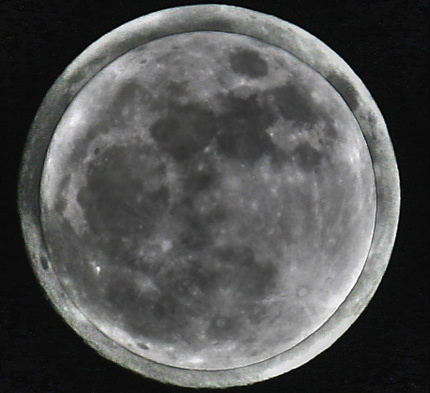
the smallest Full Moon possible superimposed over the largest Full
"Super Moon" possible (Sources: Stefano Sciarpetti, NASA).
By Glenn A. Walsh
Reporting for SpaceWatchtower
Saturday afternoon's Full Moon marks
the first (of three), so-called Full “Super Moon,” for 2015. Next
month's Full “Super Moon” on the evening of September 27-28, in
addition to being the annual "Harvest Moon" and the largest “Super
Moon” of the year, will mark what some people refer as the fourth
and last “Blood Moon” Total Lunar Eclipse.
The August Full Moon occurs Saturday
Afternoon, 2015 August 29 at 2:35 p.m. Eastern Daylight Saving Time
(EDT) / 18:35 Coordinated Universal Time (UTC). This Full Moon is
referred to as a “Super Moon” because it is close to Lunar
Perigee for the month of August
The Moon will be at Perigee, or the
closest point to Earth in its orbit around our planet for the month,
the next morning. Lunar Perigee occurs on Sunday Morning, 2015 August
30 at 11:00 a.m. EDT / 15:00 UTC, when the Moon will only be 358,290
kilometers from the Earth.
As with all Lunar Perigee Full Moons,
or “Super Moons,” larger-than-usual tides are predicted along
ocean coastlines. When the Sun, Moon, and Earth are more-or-less in a
straight line in Outer Space, which occurs each New Moon and Full
Moon, the size difference between ocean high tides and low tides is
greatest. These tides are actually called “Spring Tides,” but have
nothing to do with the season of Spring. However, when a “Spring
Tide” occurs, at the same time as a “Super Moon” (no matter
whether this “Super Moon” occurs during Full Moon or New Moon
phase), the tides are even greater than normal “Spring Tides.”
Yes, a “Super Moon” can occur
during the New Moon phase. In fact, we had three such New Moon “Super
Moons” occur earlier this year in January, February, and March. The
three Full Moon “Super Moons” this year occur on August 29,
September 27-28 (annual “Harvest Moon”), and October 27 (annual
“Hunter's Moon,” four days before the final traditional Cross-Quarter Day of
the year: Halloween). The “Super Moon” is defined as the point in
time when the center of the Moon (Full Moon or New Moon) and the
center of the Earth are less than 361,836 kilometers / 224,834
statute miles apart
In North America, the Native Americans
called the August Full Moon the Stugeon Moon, Corn Moon (sometimes
Green Corn Moon), Grain Moon, or Red Moon. The fishing tribes,
particularly near the American Great Lakes, named it the Sturgeon
Moon due to the many sturgeon caught in the Great Lakes and other
large lakes at this time.
Of course, other tribes named it the
Corn Moon or Green Corn Moon, as well as the Grain Moon, due to the
havesting of corn and grain that was underway at this time. Other
tribes referred to the August Full Moon as the Red Moon, as the Moon
more often appeared with a reddish tint, while rising during the hazy
and humid days of mid-to-late Summer.
In the Southern Hemisphere, the August
Full Moon has been known as the Snow Moon, Storm Moon, Hunger Moon,
and Wolf Moon. Of course, this is due to the Winter-type weather prevalent at this time of year hundreds of kilometers south of the Equator.
More on the "Super Moon": Link >>> https://en.wikipedia.org/wiki/Supermoon
More on the Full Moon: Link >>> http://en.wikipedia.org/wiki/Full_moon
More on Full Moon names ---
Link 1 >>> http://earthsky.org/astronomy-essentials/full-moon-names
Link 2 >>> http://www.farmersalmanac.com/full-moon-names/
Link 3 >>> https://en.wikipedia.org/wiki/Full_moon#Full_moon_names
Sun Rise / Set and Moon Rise / Set Times for Cities (U.S. Naval Observatory):
Link >>> http://aa.usno.navy.mil/data/docs/RS_OneDay.php
Source: Glenn A. Walsh Reporting for SpaceWatchtower, a project of Friends of the Zeiss.
Want to receive SpaceWatchtower blog posts in your inbox ?
Send request to < spacewatchtower@planetarium.cc >..
gaw
Glenn A. Walsh, Project Director,
Friends of the Zeiss < http://buhlplanetarium.tripod.com/fotz/ >
Electronic Mail - < gawalsh@planetarium.cc >
SpaceWatchtower Blog: < http://spacewatchtower.blogspot.com/ >
Also see: South Hills Backyard Astronomers Blog: < http://shbastronomers.blogspot.com/ >
Barnestormin: Writing, Essays, Pgh. News, & More: < http://www.barnestormin.blogspot.com/ >
About the SpaceWatchtower Editor / Author: < http://buhlplanetarium2.tripod.com/weblog/spacewatchtower/gaw/ >
SPACE & SCIENCE NEWS, ASTRONOMICAL CALENDAR:
< http://buhlplanetarium.tripod.
Twitter: < https://twitter.com/spacewatchtower >
Facebook: < http://www.facebook.com/pages/
Author of History Web Sites on the Internet --
* Buhl Planetarium, Pittsburgh:
< http://www.planetarium.
* Adler Planetarium, Chicago:
< http://adlerplanetarium.
* Astronomer, Educator, Optician John A. Brashear:
< http://johnbrashear.tripod.com >
* Andrew Carnegie & Carnegie Libraries:
< http://www.andrewcarnegie.
* Civil War Museum of Andrew Carnegie Free Library:
< http://garespypost.tripod.com >
* Duquesne Incline cable-car railway, Pittsburgh:
< http://inclinedplane.tripod.
* Public Transit:
< http://andrewcarnegie2.tripod.
Thanks for sharing, nice post! Post really provice useful information!
ReplyDeleteAn Thái Sơn với website anthaison.vn chuyên sản phẩm máy đưa võng hay máy đưa võng tự động tốt cho bé là địa chỉ bán máy đưa võng giá rẻ tại TP.HCM và giúp bạn tìm máy đưa võng loại nào tốt nhất hiện nay.